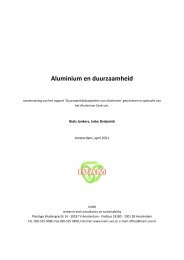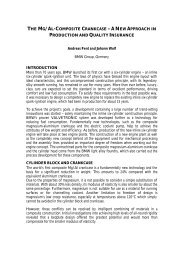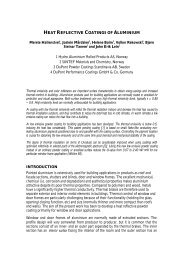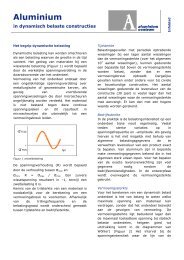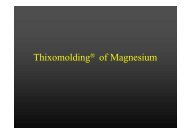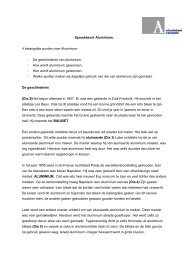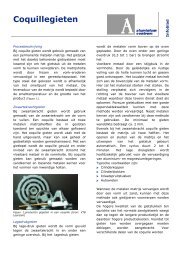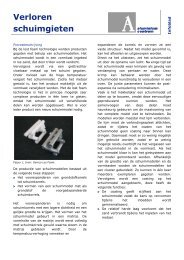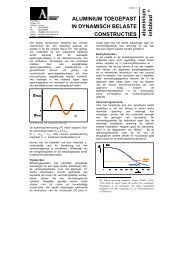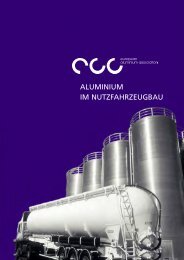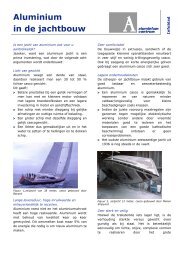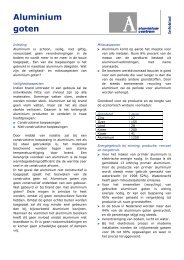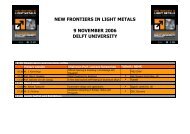3-Mr. Hugo Groeneveld - Het Aluminium Centrum
3-Mr. Hugo Groeneveld - Het Aluminium Centrum
3-Mr. Hugo Groeneveld - Het Aluminium Centrum
You also want an ePaper? Increase the reach of your titles
YUMPU automatically turns print PDFs into web optimized ePapers that Google loves.
NEW FRONTIERS WITH EXPLOSIVE FORMING<br />
<strong>Hugo</strong> <strong>Groeneveld</strong><br />
Exploform, Lelystad NL<br />
Explosive forming offers new solutions in sheet metal forming. The technology was re-introduced in 1998 and<br />
applications increase.<br />
The possibilities with explosive forming can be related to the other forming technologies by comparing the shapes that<br />
can be formed and the way how the material flows to the end shape.<br />
A forming technology can be selected for by comparing four aspects: possible shapes, properties of the products, costs<br />
and availability of the technologies. Experts can be involved after a pre-selection.<br />
The industry is challenged to inspire engineers to improve the use of technologies by focusing at applications in other<br />
branches.<br />
THE EXPLOSIVE FORMING PROCESS<br />
Explosive forming is the forming of sheet metal using explosive materials. In general, a<br />
metal sheet is placed on a die. The die cavity is vacuumed and the assembly is placed in<br />
water. An explosive charge is detonated under water pushing the sheet in the die in about 2<br />
milliseconds.<br />
Explosive forming is a valuable addition to the forming technologies for manufacturing<br />
double curved shapes. The main distinguishing factor of explosive forming is that the<br />
explosives can be applied in any mass and shape. Therefore the process does not have the<br />
restrictions in product size, shape, material and thickness.<br />
Sizes range currently at Exploform up to 10x2 meters, thicknesses from 0.3 mm aluminium<br />
to 60 mm stainless steel and many types of aluminium, titanium, stainless steel and nickel<br />
have been successfully formed by explosive forming. These ranges are not limits.<br />
The shape of the blank material can be optimized for any product shape. Sheets can be<br />
formed from flat or bent condition, or from a conical or cylindrical shape.<br />
An extreme example of applying an optimized blank shape is an explosive formed lobe<br />
mixer. A disk is folded and explosive formed in a segmented die, see Figure 1. The result is<br />
a seamless shape while the conventional method is to weld the shape from many pressed<br />
segments.<br />
Figure 1 Forming a mixer; flat blank shape; folded blank; exploded formed shape in the die; formed shape<br />
Sheets and tubes can be formed in welded condition, even when the welded sheets have<br />
different thicknesses. Good results have been achieved in steel (MIG and electrode<br />
welding), stainless steel and nickel alloys (laser and TIG welding) and aluminium (TIG and<br />
friction stir welding).
HISTORY OF EXPLOSIVE FORMING<br />
Explosive forming was applied in the 1960’s in the USA and the USSR for aerospace and<br />
space applications. But in the 1980’s applications were hard to find due to the development<br />
of other metal forming technologies that can be applied in a workshop jointly with other<br />
processes without the safety measures that come with applying explosives. Also, the<br />
technology of explosive welding was developed in the 1970’s. Companies that operated<br />
explosive forming focused to explosive welding large plates of e.g. titanium or aluminium<br />
to steel.<br />
Several factors contributed to the re-introduction of explosive forming in the 1990’s.<br />
Products with more complicated shapes were required in smaller quantities. The time-to<br />
market decreased and companies became used to subcontract specialized work. TNO<br />
started a research program in 1995 that resulted in the spin-off company Exploform B.V.<br />
in 1998 in order to make explosive forming commercially available. Exploform has a<br />
unique variety of formed products 1) .<br />
APPLICATIONS WITH EXPLOSIVE FORMING<br />
Explosive forming is mainly applied for nuclear installations, gas turbine components,<br />
architectural buildings and art. Some examples are:<br />
• Exhaust collectors for the Rolls-Royce MT30 gas turbine. The exhaust collectors<br />
are assembled from 15 large explosive formed plates. Benefits with explosive<br />
forming were the relatively low costs of the cast steel dies and the possibility to<br />
form large plates with complex shapes.<br />
• Cover plates for a nuclear water basin. The 5 mm stainless steel plates are welded<br />
from pieces and some welds were originally located at spots where the weld quality<br />
can not regularly be verified by standard procedures. Plates of 10x2 meters were<br />
explosive formed to one integrated shape eliminating these welds.<br />
Figure 2 Rolls Royce exhaust collector assembled from 15 explosively formed parts<br />
Figure 3 Explosively formed panels for a nuclear water basin<br />
• Many types of combustor liners from nickel alloys are explosive formed from<br />
cylindrical and conical shapes.<br />
• Many types of manifolds for both gas turbines with a very uniform thickness.<br />
Figure 4 Explosively formed components for the hot sections of gas turbines
• The saddle shaped corner panels of the ‘Booster Gemaal’ in Amsterdam were<br />
explosive formed from stainless steel plates in 2B surface condition.<br />
• The stars of the monument for the Maastricht Treaty were explosive formed. The<br />
stars have a complicated shape and turn by the wind.<br />
Figure 5 Saddle shaped corner panels<br />
Figure 6 Explosively formed stars for the monument of the Maastricht Treaty<br />
• 1600 panels of 1600x750 mm were explosively formed from 0.7 mm coil coated<br />
aluminium plates for the wall cladding of a theatre.<br />
Figure 7 Theatre with 1600m2 of explosively formed panels from coil coated aluminium<br />
EXPLOSIVE FORMING AND OTHER METAL FORMING TECHNOLOGIES<br />
Explosive forming is one of the many metal forming technologies. Table 1 gives an outline<br />
overview of the technologies for forming double curved sheet metal products. The<br />
differences between the technologies are basically in the way how the force is applied and<br />
how it changes during the forming process and in the starting shape of the metal.<br />
Four aspects are determining when selecting a forming technology for a certain double<br />
curved sheet metal shape. These factors are the production possibilities, the product<br />
properties, the costs and the availability of the technologies.<br />
The production possibilities are the overall shapes, sizes, metals and sheet thicknesses that can<br />
be formed within the technology limits. These limits are defined by the available press size<br />
and power and by the way how the metal is flown to the wanted shape. The material flow<br />
determines the kind of shapes that can be formed and it determines how far the metal can<br />
be formed before breaking. It also determines product properties. An indicative overview<br />
of production possibilities and material flow is listed in Table 1.
explosive forming<br />
pressing/<br />
deep drawing<br />
stretch forming<br />
superplastic forming<br />
unlimited. The explosives can be applied in<br />
any mass and shape.<br />
sizes and sheet thicknesses depend on press<br />
size and capacity. Generally up to 3x2 m. for a<br />
very large press. Products > 10 mm steel with<br />
shallow shapes only. Heating large plates<br />
before pressing improves possible size and<br />
thickness.<br />
Large, shallow shapes from thin plates (
Production<br />
properties<br />
Starting shape<br />
Applied force<br />
Product<br />
requirements<br />
Material flow<br />
Other product properties like resistance to stress corrosion or surface smoothness are<br />
sometimes determining. We focus only at three commonly evaluated properties in order<br />
keep the overview easily understandable.<br />
The costs for applying a technology are separated in initial costs and production costs. Initial<br />
costs are the costs for die manufacturing and process development. The production costs<br />
are the costs for forming one product in a production run.<br />
The costs vary for each product and each technology. Table 2 gives a general overview of<br />
the costs together with the product properties.<br />
Table 2 is indicative only and does not account for certain exceptions. For example, single<br />
pieces of large aluminium plates can be formed more economically using concrete dies with<br />
explosive forming. Or large plates can be textured economically in large quantities because<br />
a special efficient tool was developed for this specific explosive forming process.<br />
costs<br />
Shape and size<br />
Thickness<br />
Material<br />
Product<br />
properties<br />
Ductility<br />
Thinning<br />
Accuracy<br />
Figure 8. Relation between production properties, product requirements and product properties<br />
product properties<br />
Technology initial costs production costs accuracy thinning ductility<br />
spinning + + - -- -<br />
rubber pressing + + o o +<br />
hydroforming + + o + +<br />
explosive forming + - + + +<br />
pressing/deep drawing -- ++ o - o<br />
stretch forming o - ++ - o<br />
superplastic forming - -- + -- o<br />
dishing ++ o -- o o<br />
Table 2. Qualitative, general overview of costs and product properties of metalforming technologies<br />
for double curved products. +=good; -=poor.<br />
The availability of technologies is more than the availability of certain production capacity. It is<br />
also the experience of operators and their willingness and ability to develop a new forming<br />
process if a wanted product has unproven features.<br />
Most companies that operate metal forming technologies focus to certain applications.<br />
Only innovative companies will make their technology available if a wanted product does<br />
not match to current achievements or to current application fields.<br />
The four comparing factors are all both complex and dynamic and the product<br />
requirements vary for each product. This makes it very difficult to define an exact overview<br />
for selecting the most proper technology (or a mix of sequencing technologies!) for a given<br />
product.
The best approach is to understand the general basics for making a pre-selection of the<br />
applicable technologies and to involve specialists that operate the candidate technologies.<br />
Figure 2 gives a scheme for selecting a technology. This implies developing a trustful<br />
relation with specialized employees and sub contractors which makes selecting a<br />
technology even more dynamic.<br />
First selection<br />
Aspects:<br />
Production possibilities<br />
Existing solutions<br />
Designer<br />
Product requirements<br />
Basic technology knowledge<br />
Selection<br />
Aspects:<br />
Production possibilities<br />
Costs<br />
Product properties<br />
Availability<br />
Technology experts<br />
Knowledge<br />
Creativity<br />
Solution<br />
Figure 9. Scheme for selecting a technology<br />
Challenge: cross-over’s<br />
The Western industry is challenged to make optimal use of technologies. General ways to<br />
improve the use of technologies are for the directly involved parties:<br />
• For users of technologies: increase the level of knowledge of possibilities with<br />
technologies;<br />
• For operators: improve the level of skill for enhancing new technological<br />
developments;<br />
Other involved parties are government, research institutes, universities and training<br />
schools.<br />
An efficient approach for all involved parties for realizing better use of technologies is to<br />
focus at cross-over. Cross-over’s are applications of ideas for new purposes.<br />
Focus at cross-over does stimulate intuitive creativity. One can easily find inspiration by<br />
looking at solutions in other companies or branches and apply them for own purposes.<br />
This focus is particularly useful with forming technologies for double curved sheet metal<br />
products. Most of these technologies are developed in the second half of the 20 th century<br />
within a certain branch. The possibilities of cross-over’s are still wide open as can be<br />
illustrated by the fact that a comprehensive overview of all these technologies is very hard<br />
to find.<br />
Focus at cross-over is beneficial and also necessary for the Western industry. Cross-over’s<br />
are not difficult to make because there is a unique variety of technological solutions at hand<br />
with a good infrastructure for applying them. Having in mind that this year 700,000
engineers start their training in China 2) , it is also very necessary to make use of these<br />
advantages in order to remain able to add value to the world.<br />
References<br />
1) Journal of Materials Processing Technology 125-126, D.J.Mynors, B.Zhang, 3<br />
March 2002 www.elsevier.com/locate/jmatprotec<br />
2) Presented at the Seminar ‘Innovatie door cross-over’ in Rotterdam on October 6,<br />
2006 by Jan Kamminga (chairman of branch organization FME/CWM)



